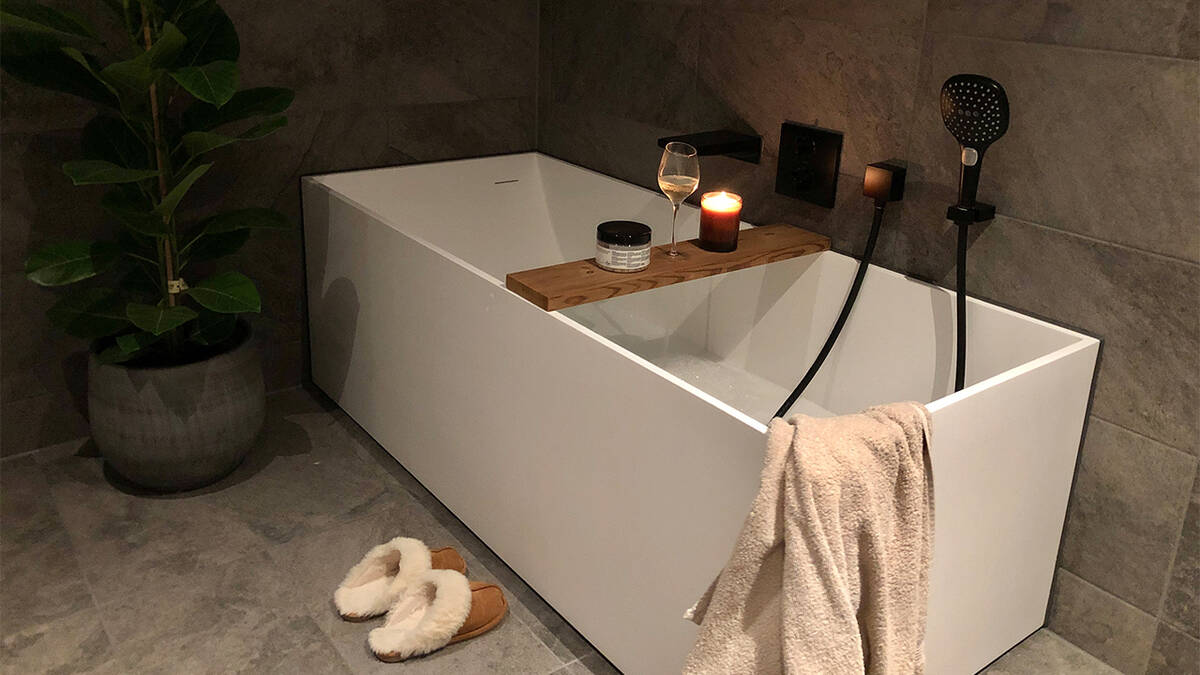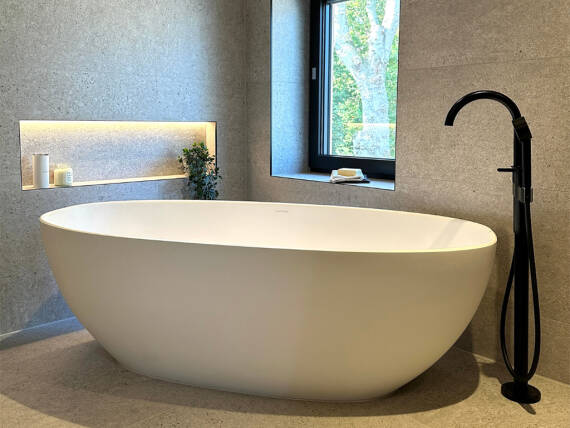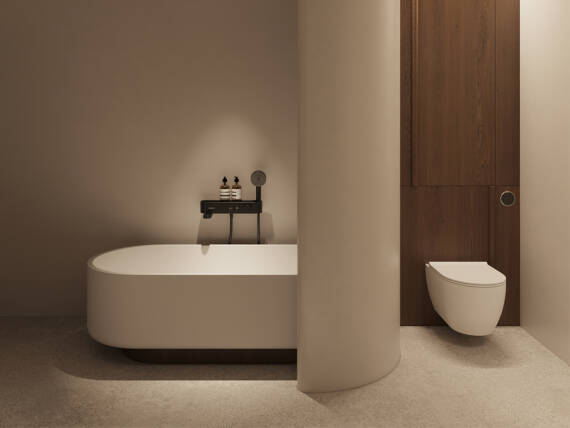Bath tub: reduce CO2 emissions
Bath tub water consumption: How to reduce your ecological footprint
We actually know that regular, hot baths have a negative impact on our personal carbon footprint. Taking a full bath consumes twice to five times more water and energy than a shower. This is not a good thing for the environment. And not to mention the costs, since all those liters and kilowatt hours are also noticeable on our bills. So if you're now saying: "I really need my bathtub! I'd rather save money on shopping and compensate my CO2 emissions by cycling", then that's completely understandable and perfectly within your rights. Relaxing, switching off and getting away from it all are incredibly important. For this reason, Hansgrohe has a solution for you.
Get rid of the bathtub and just take a shower?
As an expert in wellness, Hansgrohe develops product solutions that are designed to make everyone happy. And: the company conducts research. In everything that the Green Company develops, it takes the environment into serious consideration. Hansgrohe has had a CO2 analysis performed on your ecological footprint in the bathroom - with interesting results on how to save money in the bathtub. One thing's for sure: bathing mermaids and squeaky duck captains can breathe a sigh of relief before they dive in.

How many liters fit in a bath tub?
An average of 100 to 200 liters rush through standard bathtubs with every full bath. Giant bathtubs consume even more precious resources. Resources in the majority, because after all, every single liter of water also requires heat energy. By comparison, showers use an average of 40 to 60 liters. So you can save a lot of water, energy, greenhouse gases and costs by taking a shower. A shower beats a bath. So the CO2 balance is clear.
Reduce water consumption in the bath tub - tip 1: shower instead of bathing

Thank goodness for wellness showers. If you invest in a shower system with several spray types and feel-good modes, you can enjoy a similar time-out for body, mind and soul as if you were taking a bath. Those who choose showers with an economy function and micro-fine PowderRain jets, for example, will be delighted - by the savings potential and the wellness factor. And if you are currently renovating: Why not invest in a floor-level shower without any trip hazards? You'll be making provisions for later life.
Do you want to calculate your potential CO2 savings in the bathroom?
Ecologically designed products such as those with EcoSmart consume far less valuable resources - without compromising on comfort. Whether bathing, showering or washing your hands: With the hansgrohe water saving calculator ou can quickly find out how much water and energy you can save with hansgrohe faucets and showers.
Conserving resources and saving in the bath tub (usage phase)
The hansgrohe CO2 analysis distinguishes between „use phase" (= CO2e emissionsß during the use of a bathroom product) and „creation phase" (= CO2e emissionsß during the manufacture of a bathroom product). Here are the specific figures for the usage phase in your household:
- The Water requirement in the bath tub causes CO2e emissions of 40 kg CO2e (per complete service life of 20 years in a 4-person household)*.
- The Energy requirement for hot water in the bath tub generates 2,460 kg CO2e (per complete service life of 20 years in a 4-person household).
The results show: For you, the biggest lever for saving greenhouse gases at the bath tub is hot water, and by a wide margin. We have many opportunities to reduce our demand for hot baths and cut our costs;
*The calculations are based on a standard bathtub in a German bathroom:
Reduce water consumption in the bath tub – Tip 2: bathe less often and less hotß
- Make the full bath a luxurious exception to your bathing routine, and don't bath quite so often as usual.
- Reduce your CO2 emissions by not bathing as hot as usual.
- Use less resources by not letting the bath overflow, for example by filling it half full or using a sitting bath.
Unlike lavatory faucets, the flow rate (= water consumption of liters per minute) is not as important for bath tub faucets. After all, you want the bath tub to fill as quickly as possible for a full or half bath.

Do you shower in your bath tub?
But perhaps you are one of the many people who do not have a shower cabin - and shower in your bath tub. Clever water and energy-saving technologies are very important here. Showers with EcoSmart technology save considerable water one, keyword: „flow limiter". Do you remember? The fewer liters that need to be heated, the lower the CO2 balance and energy bill.
- Please also read our magazine article on CO2:Take a more climate-friendly shower!
Reduce your CO2 footprint with smart purchasing decisions (creation phase)
In addition to our resource-conserving behavior, we can improve our carbon footprint in the bathroom by making smart consumption decisions. Please make sure that you only buy high-quality bathroom products from the brand manufacturer buy or have installed. The bath tub faucet or the cheap shower head from the discount store often give up the ghost in no time at all. Such wear and tear products are cost eaters and hardly anything pollutes the environment as much as multiple purchases. There is another trick to saving CO2 when it comes to your beloved bath:
Reduce water consumption in the bath tub – Tip 3: have a small bath tub installed
Bath tubs with the capacity of a swimming pool leave the footprint of a giant Goliath. But we would rather be Davids. Out of responsibility for the environment and our descendants, we should do without this mega-luxury. After all, every liter of hot water makes the meter rattle and blows greenhouse gases into the atmosphere. If you are currently rethinking and renovating your bathroom:
- Take a standard tub or even better: a space-saving tray with a smaller filling volume.
Tip 4: Buy a bath tub made of non-perishable material
Materials, packaging and recyclability are also important ecological aspects of bathroom furnishings. Create your own timeless quality products that have a long service life an. And those that can be easily recycled at some point. Recyclable steel enamel or high-quality, durable acrylic are recommended as materials
- The CO2 analysis by hansgrohe puts the CO2 consumption of a bath tub made of sanitary acrylic in the construction phase at 101 kg CO2e by comparison.
Tip 5: Choose sustainable products for your bath tub
What applies to the bath tub also applies to everything you install around it: Hands off inferior plastic with a short service life. cheap plastic stuff! Instead, opt for bathroom products with a convincing life cycle assessment and suppliers who are committed to sustainable value chains and a circular economy. When buying, also look out for environmental seals, eco-certificates and test stickers. Conclusion: You can also reduce your CO2e balance in the bath tub by making sustainable purchasing decisions when it comes to bathtub materials and bath tub faucets (concealed or surface-mounted), wall coverings and tiles, hand showers, shower hoses and hose connections. Accessories and storage systems on the bath tub should also be of good, durable quality;
- You will find plenty of inspiration for bathroom planning in our Green dream bathrooms, where climate-friendly products are used.
- Here are more Water saving tips for the bathroom.
Frequently asked questions about saving CO2 in the bath tub
Yes, you use an average of 40 to 60 liters in the shower and an average of 100 to 200 liters in a full bath in a standard bath tub. So you save a lot of water, energy, greenhouse gases and costs when you shower. You can save the most with water-saving showers.
If you buy a shower system with several showers and wellness jets, you can enjoy a time-out for body, mind and soul comparable to a full bath. And yes: hansgrohe economy showers can be used with microfine PowderRain, for example. You can look forward to the savings potential and the feel-good factor.
Bathe less often and make a full bath a luxurious exception to your bathing routine. If you do take a full bath, don't bathe quite so hot. And simply don't let the bath tub fill to the brim, this also reduces your ecological footprint.
Bath tub faucets from discount stores run the risk of not being convincing due to their quality and durability. Cheaper models often tend to wear out prematurely, which can make it necessary to replace them soon. Worn products pollute the environment and cause unnecessary waste. Make sure you buy durable bathroom products from a brand manufacturer or have them installed.
When buying a bath tub, material, recyclability and durability are essential ecological criteria. It is advisable to opt for timeless quality products that offer a long service life and can be easily recycled at the end of their life cycle. For bath tubs, materials such as recyclable steel enamel and high-quality, durable acrylic are preferable.
Trusted partners